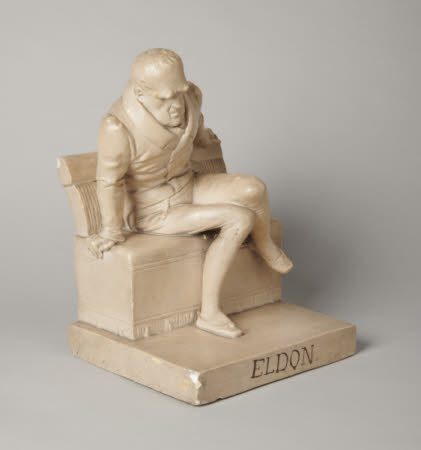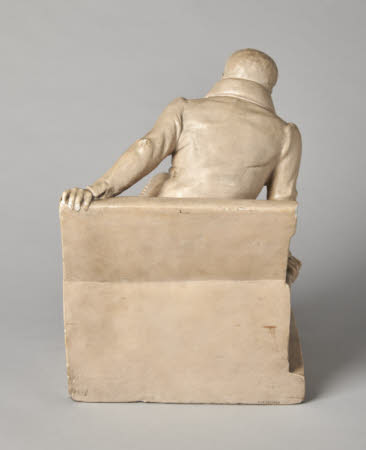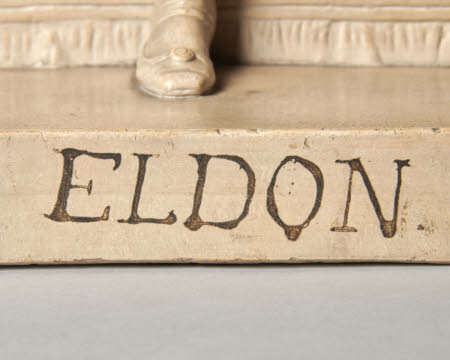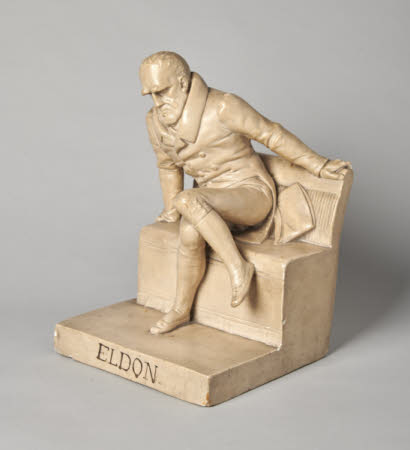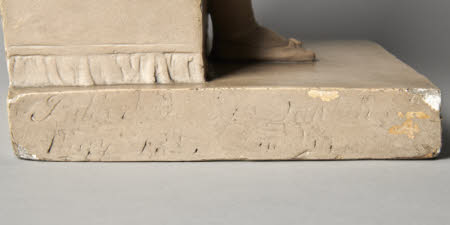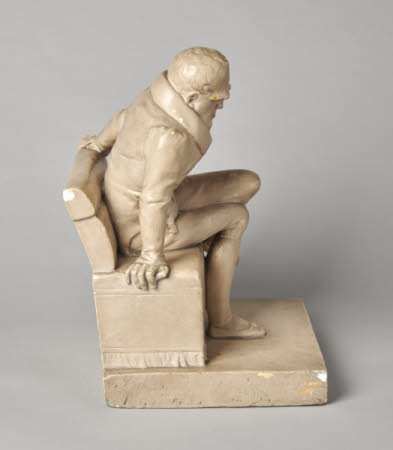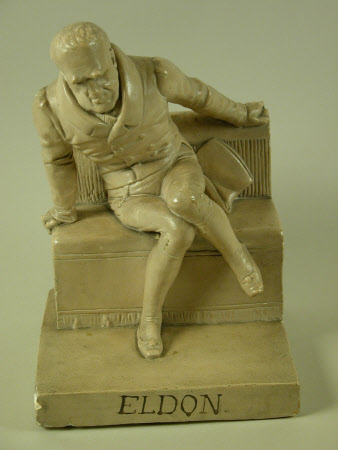Portrait statuette of William Molyneux, 2nd Earl of Sefton (1772-1838
Jean-Pierre Dantan (Paris 1800 - Baden-Baden 1869)
Category
Art / Sculpture
Date
May 1833
Materials
Plaster
Measurements
330 x 228 x 248 mm
Place of origin
London
Order this imageCollection
Mount Stewart, County Down
NT 1221046
Summary
Sculpture, patinated plaster; William Molyneux, 2nd Earl of Sefton (1772-1838); Dantan jeune (Jean-Pierre Dantan, 1800-1869); 1833. A satirical portrait of the politician and racing enthusiast, Lord Sefton, showing him propping himself up on a bench, perhaps in the House of Lords, his left leg raised. The sculpture was mistakenly labelled at the time of its making as a portrait of the lawyer John Scott, 1st Earl of Eldon (1751-1838). One of a group of seven such caricatures , known in French as ‘portraits chargés’ or ‘charges’, made by the French sculptor and satirist Dantan jeune during his first stay in London in 1833, brought to Mount Stewart from Londonderry House.
Full description
A portrait chargé or satirical portrait of William Molyneux, 2nd Earl of Sefton (1772-1838), depicting the politician seated on a bench, perhaps in the House of Lords, gripping the seat and the back of the bench in order to shift his position, and raising his left leg. He is dressed in a buttoned-up jacket and breeches; his hat is on the bench next to him. The sculpture was labelled at the time of its making as a portrait of the lawyer, politician and erstwhile Lord High Chancellor John Scott, 1st Earl of Eldon (1751-1838). This is however clearly an error, since Dantan’s portrait of Lord Eldon (Sorel 1986, p. 30, no. 89) depicts him, like the portrait of another lawyer Henry Brougham (NT 1221049), as dressed in lawyer’s robes. The present statuette in fact is a representation of the MP and peer William Molyneux, 2nd Earl of Sefton (1772-1838). William Molyneux was a long-serving MP for the Whig faction, and a loyal supporter of Henry Brougham. He went to the House of Lords as a peer in 1831. Known popularly as ‘Lord Dashalong’ because of his passion for horse racing. Charles Greville described Sefton as ‘irresistibly comical’ and noted for his ‘liveliness, persiflage and good humour, his hunting, racing, gaming and gastronomy’. He is the subject of another portrait chargé by Dantan at Mount Stewart (NT 1221045), in which the peer is shown with much more dishevelled clothes. Sefton also featured in another caricature by Dantan, the ‘Loge Anglaise’, in which Lord Sefton, Lord Adolphus FitzClarence, Georges Humwell and Lord Allen are depicted at the King’s Theatre, watching a performance of Rossini’s Barber of Seville with varying degrees of boredom (Sorel 1986, p. 101, no. 331). The two sculptures are part of a group of seven satirical statuettes by Dantan jeune at Mount Stewart (NT 1221043-1221049), all made during the sculptor’s first visits to London in 1833 and 1834. They consist of five British subjects, mostly politicians: Duke of Wellington; Earl of Sefton (twice); Samuel Rogers and Lord Brougham; and two well-known Frenchmen resident in London at the time, the diplomat Talleyrand and the comte d’Orsay. Dantan jeune (Jean-Pierre Dantan, 1800-1869) was a successful portrait sculptor, but became famous, especially during the decade of the 1830s, for his satirical sculptures, which he called Portraits chargés (‘loaded portraits’) or simply charges. For more information on Dantan and his work, see NT 1221044. Satirists had more opportunity for freedom of expression in Britain than in France, and Dantan’s British portraits chargés have been described as some of the most original and caustic of his caricatures (Sorel 1989, p. 32) and ‘as savage in treatment as any of his works’ (Seligman 1957, p. 75). During the 1830s his work was hardly less popular in London than it was in France, and he had some distinguished patrons, including the Fourth Marquess of Londonderry (1805-1872), who is thought to have acquired the group of statuettes at Mount Stewart. They were found in the house in the early twentieth century and taken to Londonderry House in London, where they were displayed in the Library. The whole group was exhibited in 1931 at the Burlington Fine Arts Club, in an exhibition on English caricature. The statuettes returned to Mount Stewart after the sale and demolition of Londonderry House in 1962. Jeremy Warren April 2022
Provenance
Probably acquired by Frederick Stewart, 4th Marquess of Londonderry (1805-1872); by descent at Mount Stewart and Londonderry House; given to the National Trust by Lady Mairi Bury (1921-2009) in 1976
Marks and inscriptions
Front of base, in ink:: ELDON Proper right side of base, incised:: Published by Dantan je/ [..] May 1833 London
Makers and roles
Jean-Pierre Dantan (Paris 1800 - Baden-Baden 1869), sculptor
References
Londonderry House 1939: A Catalogue and Valued Inventory of the Furniture and Works of Art at Londonderry House, Park Lane, W... Prepared for the purposes of insurance, with historical notes, by H. Clifford-Smith, 1939, p.142. Burlington Fine Arts Club: ‘Catalogue of a Collection of English Caricature, Winter 1931/1932’, London 1931, no. 204. Montgomery Hyde 1937 H. Montgomery Hyde, Londonderry House and its Pictures, London 1937, p. 18, Pl. IV. Hale 1940 : Richard Walden Hale, Dantan, jeune 1800-1869, and his satirical and other sculpture, especially his “portraits chargés’, Needham, Mass. 1940. Seligman 1957: Janet Seligman. Figures of fun: the caricature-statuettes of Jean-Pierre Dantan, London 1957., p. 144. Sorel 1986: Philippe Sorel, ‘Les Dantan du Musée Carnavalet. Portraits-charges sculptés de l’époque romantique’, Gazette des Beaux-Arts,, 107 (1986), pp. 1-38 and 87-102, p. 96, no. 276.
